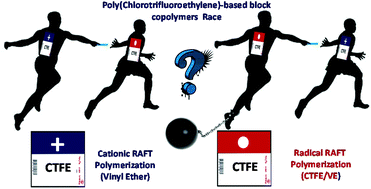当前位置:
X-MOL 学术
›
Polym. Chem.
›
论文详情
Our official English website, www.x-mol.net, welcomes your
feedback! (Note: you will need to create a separate account there.)
Synthesis of PEVE-b-P(CTFE-alt-EVE) block copolymers by sequential cationic and radical RAFT polymerization†
Polymer Chemistry ( IF 4.1 ) Pub Date : 2017-12-08 00:00:00 , DOI: 10.1039/c7py01924f Marc Guerre 1, 2, 3, 4, 5 , Mineto Uchiyama 6, 7, 8, 9, 10 , Gérald Lopez 1, 2, 3, 4, 5 , Bruno Améduri 1, 2, 3, 4, 5 , Kotaro Satoh 6, 7, 8, 9, 10 , Masami Kamigaito 6, 7, 8, 9, 10 , Vincent Ladmiral 1, 2, 3, 4, 5
Polymer Chemistry ( IF 4.1 ) Pub Date : 2017-12-08 00:00:00 , DOI: 10.1039/c7py01924f Marc Guerre 1, 2, 3, 4, 5 , Mineto Uchiyama 6, 7, 8, 9, 10 , Gérald Lopez 1, 2, 3, 4, 5 , Bruno Améduri 1, 2, 3, 4, 5 , Kotaro Satoh 6, 7, 8, 9, 10 , Masami Kamigaito 6, 7, 8, 9, 10 , Vincent Ladmiral 1, 2, 3, 4, 5
Affiliation

|
Block copolymers containing chlorotrifluoroethylene (CTFE) are relatively rare. This article presents the synthesis of unprecedented CTFE-containing block copolymers (PEVE-b-P(CTFE-alt-EVE)), where EVE stands for ethyl vinyl ether, via sequential cationic and radical Reversible Addition–Fragmentation chain Transfer (RAFT) polymerizations. Two synthetic pathways were followed and compared: (1) synthesis of a PEVE block by cationic RAFT polymerization from a P(CTFE-alt-EVE) macromolecular Chain Transfer Agent (macroCTA) prepared by radical RAFT copolymerization, and (2) synthesis of a P(CTFE-alt-EVE) block by radical RAFT copolymerization from a PEVE macroCTA prepared by cationic RAFT polymerization. Careful chain-end analysis using 1H and 19F NMR spectroscopies revealed that irreversible transfer reactions severely affected the chain-end fidelity of the P(CTFE-alt-EVE) macroCTA. In addition, the penultimate CTFE unit of these macroCTAs seemed to adversely alter the reactivity of the –CH2-CH(OEt)-XA end-group under cationic RAFT conditions. The chain extension of these macroCTAs by cationic RAFT polymerization thus led to poorly defined block copolymers. Nevertheless, both xanthate and dithiocarbamate RAFT agents were shown to provide efficient control over the radical RAFT copolymerization of CTFE and EVE. In contrast, the cationic RAFT polymerization of EVE afforded PEVE macroCTAs with high chain-end fidelity and chain extension reactions resulting in well-defined PEVE-b-P(CTFE-alt-EVE) block copolymers with low dispersities (Đ < 1.35).
中文翻译:

通过顺序阳离子和自由基RAFT聚合 合成PEVE- b -P(CTFE- alt -EVE)嵌段共聚物†
含有三氟氯乙烯(CTFE)的嵌段共聚物相对较少。本文介绍了前所未有的含CTFE的嵌段共聚物(PEVE- b -P(CTFE- alt -EVE))的合成方法,其中EVE代表乙基乙烯基醚,通过顺序的阳离子和自由基可逆加成-断裂链转移(RAFT)聚合反应。遵循并比较了两种合成途径:(1)通过自由基RAFT共聚制备的P(CTFE- alt -EVE)大分子链转移剂(macroCTA)通过阳离子RAFT聚合合成PEVE嵌段,以及(2)合成a P(CTFE- ALT-EVE)通过由自由基RAFT聚合反应制得的PEVE macroCTA进行自由基RAFT共聚而嵌段。使用1 H和19 F NMR光谱进行的仔细的链端分析表明,不可逆的转移反应严重影响了P(CTFE- alt -EVE)macroCTA的链端保真度。另外,这些macroCTA的倒数第二个CTFE单元似乎不利地改变了–CH 2的反应活性。-CH(OEt)-XA端基在阳离子RAFT条件下。这些大分子CTAs通过阳离子RAFT聚合的链增长因此导致嵌段共聚物的定义不清。然而,黄原酸酯和二硫代氨基甲酸酯RAFT剂均显示出可有效控制CTFE和EVE的自由基RAFT共聚。相比之下,EVE的阳离子RAFT聚合可提供具有高链端保真度和扩链反应的PEVE macroCTAs,从而形成定义明确的PEVE- b -P(CTFE- alt -EVE)嵌段共聚物,且分散度低(Đ <1.35)。
更新日期:2017-12-08
中文翻译:

通过顺序阳离子和自由基RAFT聚合 合成PEVE- b -P(CTFE- alt -EVE)嵌段共聚物†
含有三氟氯乙烯(CTFE)的嵌段共聚物相对较少。本文介绍了前所未有的含CTFE的嵌段共聚物(PEVE- b -P(CTFE- alt -EVE))的合成方法,其中EVE代表乙基乙烯基醚,通过顺序的阳离子和自由基可逆加成-断裂链转移(RAFT)聚合反应。遵循并比较了两种合成途径:(1)通过自由基RAFT共聚制备的P(CTFE- alt -EVE)大分子链转移剂(macroCTA)通过阳离子RAFT聚合合成PEVE嵌段,以及(2)合成a P(CTFE- ALT-EVE)通过由自由基RAFT聚合反应制得的PEVE macroCTA进行自由基RAFT共聚而嵌段。使用1 H和19 F NMR光谱进行的仔细的链端分析表明,不可逆的转移反应严重影响了P(CTFE- alt -EVE)macroCTA的链端保真度。另外,这些macroCTA的倒数第二个CTFE单元似乎不利地改变了–CH 2的反应活性。-CH(OEt)-XA端基在阳离子RAFT条件下。这些大分子CTAs通过阳离子RAFT聚合的链增长因此导致嵌段共聚物的定义不清。然而,黄原酸酯和二硫代氨基甲酸酯RAFT剂均显示出可有效控制CTFE和EVE的自由基RAFT共聚。相比之下,EVE的阳离子RAFT聚合可提供具有高链端保真度和扩链反应的PEVE macroCTAs,从而形成定义明确的PEVE- b -P(CTFE- alt -EVE)嵌段共聚物,且分散度低(Đ <1.35)。









































 京公网安备 11010802027423号
京公网安备 11010802027423号